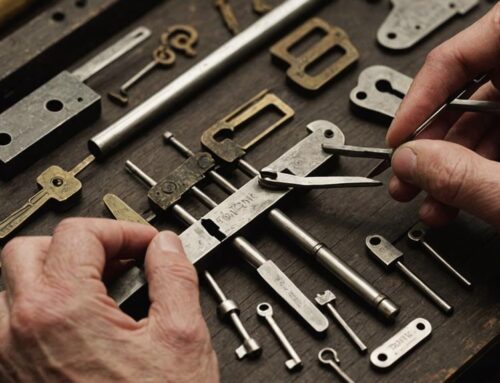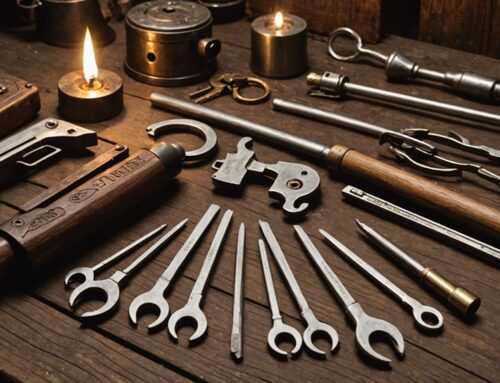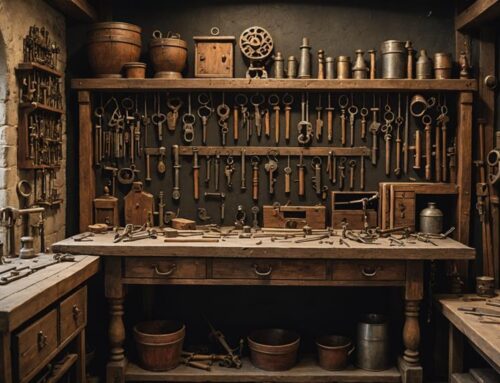You’re about to unlock a new skill – lock picking! It’s not just for spies, it can be a real lifesaver in a pinch. You don’t need fancy tools; a bobby pin or paperclip does the trick. This guide will teach you to craft your own lock pick tools and use them like a pro. But remember, with great power comes great responsibility. So, ready to dive into this practical, intriguing art? Let’s get cracking!
Key Takeaways
- Homemade lock pick tools can be easily made using bobby pins or paper clips, which are commonly found in households and offices.
- The tension wrench is a crucial tool for successful lock picking, as it allows for rotational movement of the lock cylinder.
- The single-pin pick is used to lift and push up each pin in the lock, one at a time, until the lock is successfully picked.
- Alternatively, a lock picking kit can be purchased for better results, which includes tools like a tension wrench, rake tool, and single-pin pick.
Understanding the Basics of Lock Mechanism
To truly master lock picking, it’s crucial that you understand how each component of a lock mechanism works. You’ll encounter different types of locks in your journey, each with their own vulnerabilities. Pin tumbler locks, for instance, are susceptible to raking, while wafer locks can often be rocked open.
However, it’s not just about the technical aspects. The ethical considerations in lock picking are equally important. You’ve got to ensure you’re using this skill responsibly. Remember, it’s illegal to pick locks that aren’t yours, or without permission. This isn’t about breaking the law, but understanding it, respecting it, and becoming part of a community built on trust and integrity. So, let’s delve in, learning together and always prioritizing ethics in our lock picking journey.
Crafting Your Own Lock Pick Tools
Your creativity will be put to the test when crafting your own lock pick tools from household items like bobby pins and paper clips. You’ll find the advantages of homemade tools to be many, not least of which is the sense of accomplishment and belonging you’ll feel. Yet, it’s important to avoid common mistakes in lock picking.
| Advantages | Common Mistakes |
|---|---|
| Accessibility of materials | Incorrect tension |
| Cost-effectiveness | Rushing the process |
| Learning opportunity | Not feeling the pins |
| Sense of accomplishment | Overlifting pins |
Mastering the Use of Tension Wrench
In mastering the use of a tension wrench, you’ll find that maintaining consistent pressure is the key to successfully picking a lock. It’s a delicate balance. Apply too much force, and you risk damaging the lock; too little, and you won’t engage the pins correctly. Mastering tension control is crucial in advanced lock picking techniques. It’s your tension wrench that holds the pins at the shear line, enabling you to pick each pin sequentially. You’ll feel a slight give, a gentle turn of the plug as each pin sets. Remember, lock picking is a tactile craft. Your touch, your feel, and your understanding of the lock are what set you apart. Keep practicing, and soon, you’ll be part of our community of adept lock pickers.
Techniques for Using the Single-Pin Pick
You’ve mastered the tension wrench, and now it’s time to delve into the techniques for using the single-pin pick. Understanding the art of picking multiple pins simultaneously is key to advanced lock picking techniques.
- Start by inserting the single-pin pick into the lock.
- Feel for the pins pushing back against the pick.
- Start with the pin that gives the most resistance.
- Apply gentle pressure to the pin and simultaneously apply tension with the wrench.
- Progressively move to the next pin.
Mastering this technique will help you open locks smoothly and efficiently. Remember, lock picking should only be used responsibly and ethically. Keep practicing, keep learning, and soon, you’ll be a pro at this intriguing craft. You belong in the community of advanced lock pickers.
Step-by-Step Process of Picking a Lock
While mastering the compound noun ‘single-pin pick’, you’ll also need to understand the tension wrench, and this will lead you through the step-by-step process of picking a lock. You’ll start by inserting the tension wrench into the keyhole, applying slight pressure to hold the lock open. With your single-pin pick, you’ll probe each pin in the lock, pushing them above the cylinder one at a time.
Here’s a simple guide to remember:
| Step | Action |
|---|---|
| 1 | Insert tension wrench |
| 2 | Apply pressure |
| 3 | Insert single-pin pick |
| 4 | Push pins above cylinder |
Overcoming Common Obstacles in Lock Picking
You’re doing great at lock picking, but sometimes you might encounter stubborn pins or worn-out locks, and it’s important to learn how to overcome these common obstacles. This skill is essential in picking difficult locks and picking locks without leaving evidence.
- Troubleshooting stubborn pins:
- If a pin won’t budge, ease off the tension. Too much pressure can jam the pin.
- Rake the lock. This can potentially set the stubborn pin.
- Dealing with worn-out locks:
- Use a half-diamond pick. Its wedge shape can maneuver in worn-out locks.
- Try a bump key. It can work wonders on older, worn locks.
Advantages of Using a Lock Picking Kit
There are several advantages when you use a lock picking kit, including having a variety of tools at your disposal to tackle different types of locks. As a hobby, lock picking can be both intriguing and rewarding. It tests your patience and enhances your understanding of mechanics. However, it’s important to remember the legality and ethics of lock picking. It’s a skill that you must use responsibly, never on locks that aren’t yours or without permission. The pros certainly outweigh the cons, but it’s essential to be aware of potential downsides. There’s a sense of belonging within the lock picking community, where discussions on techniques and experiences are shared. So, if you’re respectful, diligent and ethical, lock picking can be a rewarding hobby.
Tips for Improving Your Lock Picking Skills
In mastering lock picking, it’s crucial that you practice consistently to get a feel for different locks. Remember, it’s not just about twisting and turning. Here’s a list to help:
- Avoid Common Mistakes
- Don’t apply too much pressure. It could break your tools or the lock.
- Don’t rush. Patience is key here.
- Learn Advanced Techniques
- Raking: This quick, less precise method involves a swift scrubbing motion over the pins.
- Single Pin Picking (SPP): This method requires more skill, picking each pin individually.
Stay persistent, keep practicing. Lock picking is an art, and like any art form, you’ll make mistakes and face frustrations. But, don’t be discouraged. The sense of achievement you’ll feel once you’ve mastered this skill will be worth it.
Frequently Asked Questions
What Are the Legalities Surrounding Lock Picking and the Use of Homemade Lock Pick Tools?”
You must understand lock picking ethics and the legality of homemade tools. In most places, owning lock picks isn’t illegal unless used for criminal activities. Always respect privacy and only pick locks you own.
What Safety Precautions Should Be Taken When Attempting to Pick a Lock?”
Always remember safety first. Lock lubrication is important to prevent damage. Discuss picking ethics before starting, ensuring it’s for legal, educational purposes. Always pick locks you own or have explicit permission to pick.
Can Any Lock Be Picked Using These Methods or Are There Specific Types That Require Different Techniques?”
Just like puzzles vary, not all locks can be picked with these methods. Lock design evolution has led to picking resistant locks that require unique techniques. It’s about finding the right key to each puzzle.
How Long Does It Usually Take to Master the Art of Lock Picking?”
Mastering lock picking varies with individual aptitude and practice. With consistent picking practice techniques and adherence to lock picking ethics, you’ll likely see significant progress in a few months to a year.
Are There Professional Courses or Certifications Available for Those Interested in Lock Picking?”
Yes, there are professional courses that pave the way to locksmith careers. These often cover lock picking ethics, ensuring you’re equipped with skills and knowledge to use them responsibly and within the legal boundaries.








